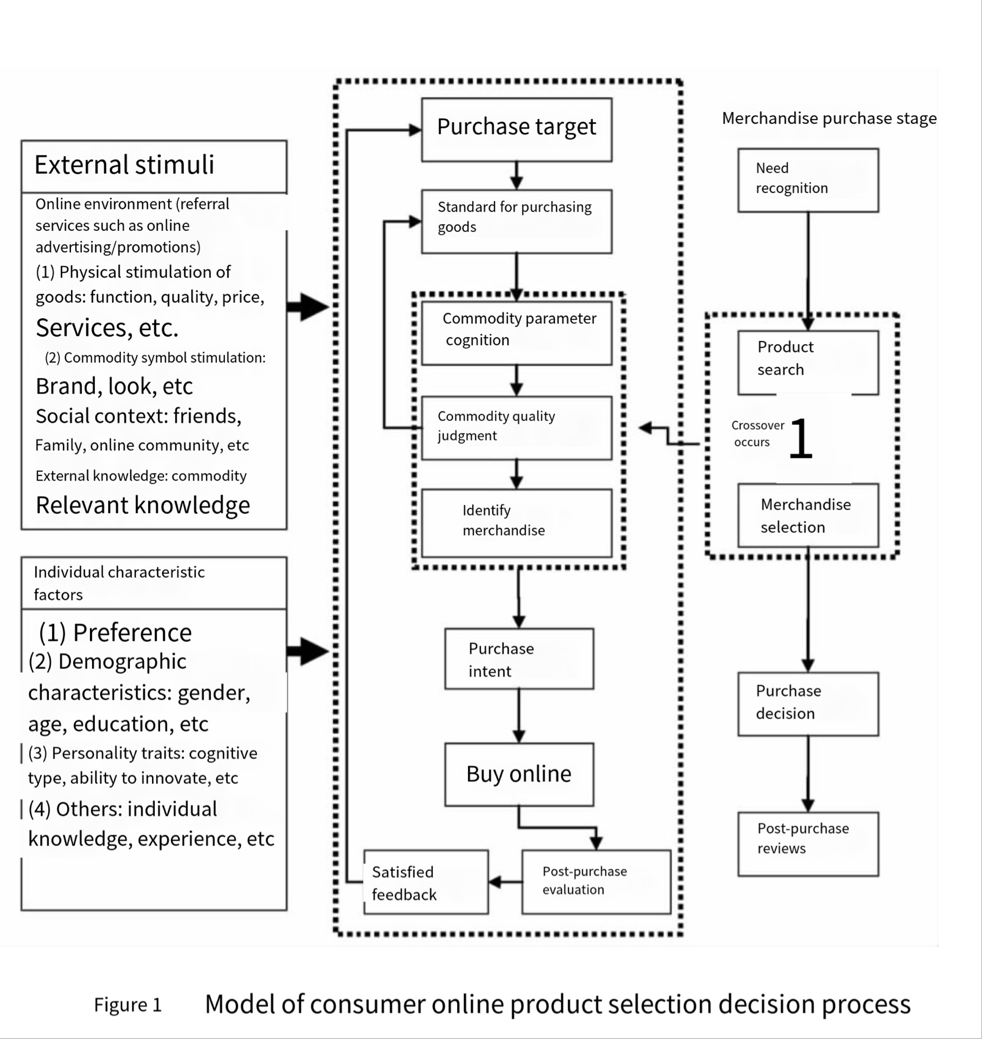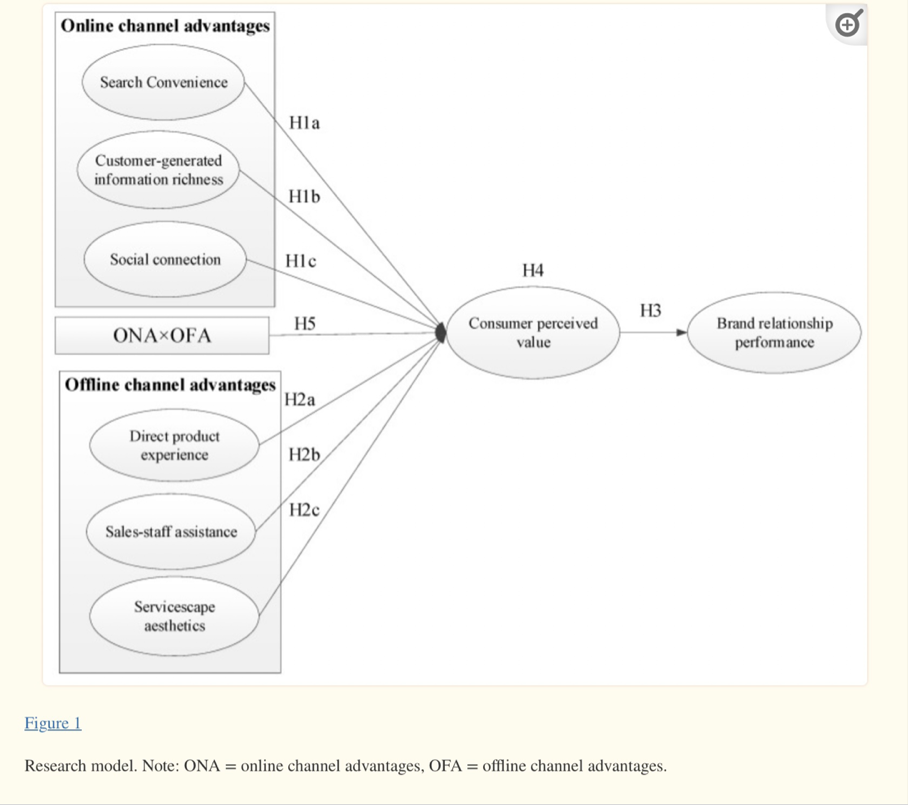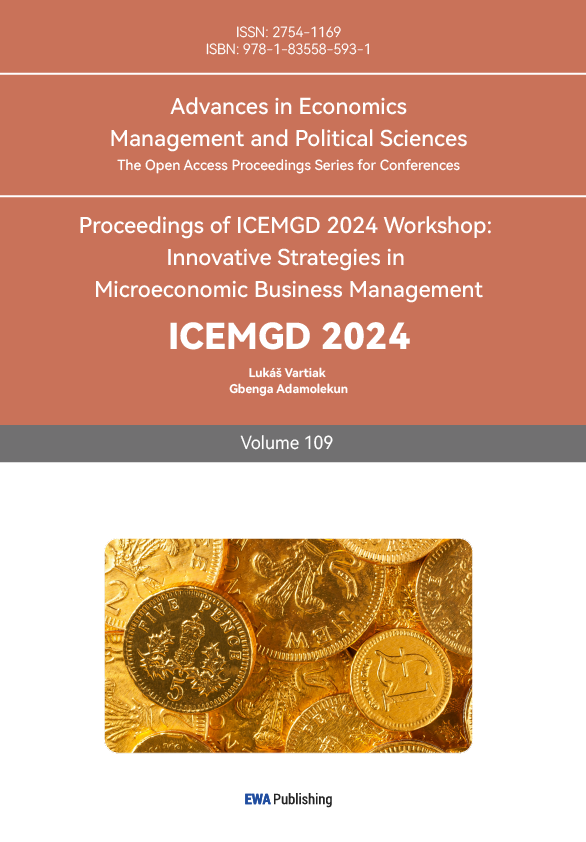1. Introduction
With the development of The Times and the gradual progress of society, the Internet has brought convenience to everyone and changed everyone's way of life. The introduction of the Internet has stimulated the interest of the first batch of new economy entrepreneurs, who believe that traditional trade information can be communicated and disseminated through the Internet, thus bringing business opportunities. Consumers order their favorite products on their mobile phones through short videos on various platforms and recommendations from major bloggers. Of course, big data also changes the decision-making of consumers. Through big data analysis (such as analyzing the number of clicks and stay time of consumers on certain kinds of short videos or products), consumers are recommended products that are more in line with their preferences, so as to make them consume more. Different from traditional consumption, consumers do not need to go out to purchase goods by clicking "one-click order" on the mobile phone, and then the goods will be delivered by the seller and then transported by major express companies, and the logistics status will be displayed on the mobile phone in real time and finally arrive at the parcel collection point set up near the consignee's address. In the whole process, consumers only need to give some time to pick up their purchased goods at the parcel station after placing the order. Thus, avoiding the traditional consumption of time and energy loss and a series of problems such as single goods. So how are consumer preferences formed? And how do online shopping platforms guide and change consumers' strategies? As far as the current literature is concerned, the research on consumers' decision-making behavior preference mainly focuses on the influence of individual characteristics on consumers' online behavior, such as Gender, age and so on.
2. Background information
2.1. Consumer decision model
The consumer's decision-making process is not always linear, and consumers may switch back and forth between stages of the purchase process. Consumers spend most of their time and energy in the three key stages of the decision-making process: obtaining information, evaluating options, and buying. Online consumption, on the other hand, is usually stimulated by external factors such as: physical stimulation of goods: function, quality, price, service, etc.
Product symbol stimulation: brand, appearance, etc. Social environment: friends, family, online community, etc.
External knowledge: knowledge about the product. And individual characteristic factors such as: preference; demographic characteristics: gender, age, education level; personality characteristics: cognitive type, innovation ability, etc. 4) Others: influenced by individual knowledge [1]. The process from having purchase goals and criteria to judging and comparing products will cross over in product search and selection. Finally determine the product to buy online and then give the purchase evaluation and feedback. To sum up, this is the decision model of consumers' online product selection amount. As shown in Figure 1, however, many "research shoppers" use both online and offline channels to collect information and evaluate products and choose one of them for transaction; This cross-channel shopping behavior is known as "hybrid search and online purchase" (or offline purchase). Exploring channel-related factors that influence the cross-channel shopping experience is necessary and may help retailers leverage channel characteristics to effectively intercept purchases at specific stages of the decision-making process fee, so that the good price group is very large in Figure 1 [2].

Figure 1: Model of consumer online product selection decision process
2.2. Complementary advantages of consumption channels
Online and offline channels have different competitive advantages and costs. Choudhury and Karahanna propose that convenience, trust and information accessibility are the advantages of digital channels over physical channels [3]. For example, the convenience of online shopping is what many people value when buying. Most people do not like to spend countless hours shopping, either in stores or online, and it is better to complete these experiences as soon as possible [4]. This is one of the main reasons why online shopping is becoming more and more popular, as it allows you to switch retailers and products with the click of a button instead of going to a new store in person. At Marks & Spencer, for example, you can buy a whole Christmas list of different products. The convenience of offline shopping is reflected in the fact that you can intuitively feel the quality of the product and truly achieve "what you see is what you get," rather than receiving the product after the buyer shows, and the seller shows, the difference leading to return. At the same time, online shopping is cost-effective, and saving as much money as possible is an integral part of any shopping experience. People love to shop online because you can often find products cheaper there than in physical stores [5]. To balance this out, however, there are often additional delivery charges that can offset the money you save on the base price. While offline shopping has no delivery fees and instead consumes mental expenses. However, on the basis of weighing the advantages and costs of different channels, some consumers will use each other and adopt different cross-channel shopping patterns. Some consumers take the online channel as the main shopping channel, and the physical store as the supplementary channel. Electronic channels offer advantages in mobility and search convenience that brick-and-mortar stores cannot match. Online reviews, which consumers value at the pre-sale stage, are not available in the physical channel. But brick-and-mortar stores offer shoppers many face-to-face services, such as multi-sensory contact with products, personalized consultation, and the perception of the aesthetics of service escape. According to the above information, the simultaneous development of online and offline shopping satisfies the diversity of customer needs, maximizes the benefits of consumers, improves consumption value and improves satisfaction in Figure 2.

Figure 2: Research model. Note: ONA = online channel advantages, OFA = oflline channel advantages [5].
2.3. Research
2.3.1. Little Red Book
Take XiaoHongshu as an example to explore the groups who shop in XiaoHongshu and their preferences. First, XiaoHongshu has a huge group of young users: XiaoHongshu's users are mainly young people, who are sensitive to new things and willing to try various educational products and services.Strong atmosphere of content sharing: There are many content sharing users in XiaoHongshu, who attract a large number of fans to shop by sharing their real experience. But fierce competition: In the small red book competition is fierce, you need to have a unique brand image and quality content to stand out. Diversification of user needs: Different users have different needs, and it is necessary to develop personalized operation strategies for different needs [6].
2.3.2. User Groups
According to the survey data of active users, women account for nearly 80% and men account for more than 20%; The age distribution of users, 18-24 years old accounted for more than 39%, 25-34 years old accounted for more than 38%, the two age groups accounted for a similar proportion; In the distribution of city levels, first-tier cities and new first-tier cities account for a relatively high proportion, accounting for nearly 70%, followed by second-tier cities accounting for more than 16%. The proportion of the weekly active time distribution of users is close, which is in the range of 13%-15% [6]. The main active users of XiaoHongshu are still young women in first - and second-tier cities, and male active users are also growing. In the meantime. In addition to the under-25 age group, the 25-34 age group is also becoming the backbone [7-10]. These active groups, they love life, strong consumption power, shopping choices to share the depth of interactive behavior, promote the change of consumption structure and consumer market.
3. Conclusion
The advent of the internet has revolutionized consumer buying behavior, significantly altering traditional consumption patterns. The convenience brought by online shopping platforms has not only simplified the purchasing process but has also enhanced the decision-making experience for consumers. By leveraging big data analytics, these platforms can predict consumer preferences with remarkable accuracy, offering personalized recommendations that drive higher engagement and increased sales.
This transformation is evident in the way consumers interact with online content, such as short videos and influencer endorsements, which play a pivotal role in shaping their purchasing decisions. The ease of making purchases through mobile devices and the streamlined logistics process further contribute to the growing preference for online shopping over traditional methods.
The ability of online platforms to influence consumer preferences and decision-making strategies underscores the need for a deeper understanding of these dynamics. Future research should continue to explore the impact of various individual characteristics on online consumer behavior, as well as the mechanisms through which online shopping platforms guide and modify consumer strategies.
In conclusion, the integration of the internet into everyday life has brought about profound changes in consumer behavior. Online shopping platforms have not only made purchasing more convenient but have also introduced new ways of influencing and predicting consumer preferences. As technology continues to evolve, so too will the strategies employed by these platforms, further shaping the landscape of consumer buying behavior.
Through the analysis of XiaoHongshu user groups and the study of XiaoHongshu push process, it can be concluded that online consumption facilitates people's life, enables people to access more of their favorite commodities, improves the purchase rate, saves shopping time and avoids shopping fatigue. Looking for what you want on the Internet, there is no need to go to the physical store, saving time and effort. Lower prices on goods. Because online stores simplify the process from manufacturer to retailer, and save on rent and other expenses that brick-and-mortar sales places pay, goods are generally priced at varying degrees below the market retail price. There is a wide range of goods. Online stores include just about everything imaginable, and you can even find something you've liked for a long time. You can compare products. When shopping online, you can open multiple pages at the same time, browse the price of the same product in multiple stores, and compare various aspects before buying. Convenient gift and payment. The one-stop service provided by e-commerce websites can be directly sent to each other's hands, direct transfer, in one step to improve consumption and change people's lifestyle.
References
[1]. Li Shuangshuang, Chen Yiwen, & Li Jiangyu. (2006). Analysis of consumers' online shopping decision model.
[2]. Tu H W, & Zhou X. (2011). Review and Prospect of consumer channel migration behavior.Foreign Economy and Management, 6.
[3]. Choudhury V., Karahanna E. The relative advantage of electronic channels: A multidimensional view. MIS Q. 2008;32:179-200. doi: 10.2307/25148833. [CrossRef] [Google Scholar]
[4]. Zhao, Y., Zhao, X., & Liu, Y. (2022). Exploring the impact of online and offline channel advantages on brand relationship performance: the mediating role of consumer perceived value. Behavioral Sciences, 13(1), 16.
[5]. Hou Min, Zhang Yao, & Gu Chunmei. (2017). A comparative study on online and Offline consumer shopping experience. Statistics and Decision, (6), 54-58.
[6]. Yang Anran. (2016). Li Haojun started from the crowd to see the trend and find the direction, and hit the little Red Book and Keep. Chuangchuang State, (5), 112-113.
[7]. Feng Runliu, & Qu Hongian. (2023). The Influence of social e-commerce platform promotion strategies of clothing brands on consumers' purchase intention: A case study of XiaoHongshu.Journal of Xian Polytechnic University, 37(4).
[8]. Wang Dandan. (2024). Research on Operational Strategy Design of virtual content Platform - A case study of XiaoHongshu. Design, 9, 361.
[9]. Gilly, M. C., & Wolfinbarger, M. (2000). A comparison of consumer experiences with online and offline shopping. Consumption, Markets and Culture, 4(2), 187-205.
[10]. Chu Jiali, & Li Ziying. (2018). Analysis of marketing skills -- taking XiaoHongshu APP as an example. Taxation, (11), 137-138.
Cite this article
Liu,Z. (2024). Transformations in Consumer Buying Behavior: Investigating How Online Shopping Platforms. Advances in Economics, Management and Political Sciences,109,181-186.
Data availability
The datasets used and/or analyzed during the current study will be available from the authors upon reasonable request.
Disclaimer/Publisher's Note
The statements, opinions and data contained in all publications are solely those of the individual author(s) and contributor(s) and not of EWA Publishing and/or the editor(s). EWA Publishing and/or the editor(s) disclaim responsibility for any injury to people or property resulting from any ideas, methods, instructions or products referred to in the content.
About volume
Volume title: Proceedings of ICEMGD 2024 Workshop: Innovative Strategies in Microeconomic Business Management
© 2024 by the author(s). Licensee EWA Publishing, Oxford, UK. This article is an open access article distributed under the terms and
conditions of the Creative Commons Attribution (CC BY) license. Authors who
publish this series agree to the following terms:
1. Authors retain copyright and grant the series right of first publication with the work simultaneously licensed under a Creative Commons
Attribution License that allows others to share the work with an acknowledgment of the work's authorship and initial publication in this
series.
2. Authors are able to enter into separate, additional contractual arrangements for the non-exclusive distribution of the series's published
version of the work (e.g., post it to an institutional repository or publish it in a book), with an acknowledgment of its initial
publication in this series.
3. Authors are permitted and encouraged to post their work online (e.g., in institutional repositories or on their website) prior to and
during the submission process, as it can lead to productive exchanges, as well as earlier and greater citation of published work (See
Open access policy for details).
References
[1]. Li Shuangshuang, Chen Yiwen, & Li Jiangyu. (2006). Analysis of consumers' online shopping decision model.
[2]. Tu H W, & Zhou X. (2011). Review and Prospect of consumer channel migration behavior.Foreign Economy and Management, 6.
[3]. Choudhury V., Karahanna E. The relative advantage of electronic channels: A multidimensional view. MIS Q. 2008;32:179-200. doi: 10.2307/25148833. [CrossRef] [Google Scholar]
[4]. Zhao, Y., Zhao, X., & Liu, Y. (2022). Exploring the impact of online and offline channel advantages on brand relationship performance: the mediating role of consumer perceived value. Behavioral Sciences, 13(1), 16.
[5]. Hou Min, Zhang Yao, & Gu Chunmei. (2017). A comparative study on online and Offline consumer shopping experience. Statistics and Decision, (6), 54-58.
[6]. Yang Anran. (2016). Li Haojun started from the crowd to see the trend and find the direction, and hit the little Red Book and Keep. Chuangchuang State, (5), 112-113.
[7]. Feng Runliu, & Qu Hongian. (2023). The Influence of social e-commerce platform promotion strategies of clothing brands on consumers' purchase intention: A case study of XiaoHongshu.Journal of Xian Polytechnic University, 37(4).
[8]. Wang Dandan. (2024). Research on Operational Strategy Design of virtual content Platform - A case study of XiaoHongshu. Design, 9, 361.
[9]. Gilly, M. C., & Wolfinbarger, M. (2000). A comparison of consumer experiences with online and offline shopping. Consumption, Markets and Culture, 4(2), 187-205.
[10]. Chu Jiali, & Li Ziying. (2018). Analysis of marketing skills -- taking XiaoHongshu APP as an example. Taxation, (11), 137-138.









